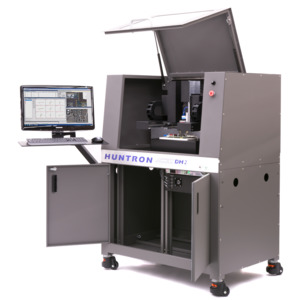
- Description
- Specifications
- Documents
99-0436 Access DH2 Prober w/Tracker & Controller
Features:
- Number of Test Heads: 2
- Maximum Board Under Test Size: 27in x 23in
- Maximum Probing Area: 19in x 12in
- Maximum Board Component Height: 4.8in
- Accuracy and Resolution: 0.0003937in (
10 microns) for Top Slot (6in above plate) at 0.00002in (0.4 microns) - Tracker & Controller - Monitor/Keyboard/Mouse
Includes: 2 cameras for top down viewing, Workstation SW, CD manual, power cord, lube, test cables, probe kit, USB cable, tool kit, board holder kit, and USB microscope.
Highlights:
- Cost effective, open architecture robotic platform
- Design, manufacturing and service depot applications
- Increase operator productivity
- Repeatable, accurate X, Y and Z movement
- Easy access to probing area
- Dual head flying probe interface for true point-to-point testing
- Sized for small to large PCAs
- Exceptional accuracy for precise probing of PCAs
- Internal Huntron Tracker and rack mounted Computer
- RG316 coax cable to the probes used for high-frequency measurements
- Configured for 4-wire resistance testing when used with the optional 4-Wire Test Kit
- Durable, stand alone cabinet design for many years of service
- Built-in side by side 19in racks provide plenty of space for PC and integrated test instrumentation
- Automate tests using other mainline test instruments with optional SDK packages
The Access DH2 Prober is a dual head Robotic Flying Probe system that is best suited for low volume PCA testing where interfacing between two points is necessary. The Access DH2 stands in it's own cabinet with plenty of space underneath for a rack mounted PC and other test instrumentation. The open architecture design of the Access DH2 makes it possible for you to utilize flying probe technology with many different test methods where automated probing of the PCA under test makes sense. The Access DH2 can be used with traditional Huntron Tracker products, configured to work with many conventional test instruments. The Access DH2 design allows a plug and play approach to automating manual guided probe applications.
